Homeschooling
has been a somewhat ambiguous idea for most people in the past. There have been
a lot of narratives pushed about the homeschool lifestyle with varying levels
of credibility. Some are good, some are bad; many tend to be more of the
exception than the rule. Nevertheless, the stories that have been spun lead to
some confusion among outsiders as to the true nature of homeschooling. This
book is an attempt to remedy that, and to encourage parents that, though
daunting, homeschooling is a possible, worthwhile venture that often leads to
better parent-child relationships and more well-rounded individuals.
Homeschooling,
quite simply, is teaching children academic principles at home. In the early
years, this often includes math, writing, and reading, along with some basic
science, and maybe some art or music studies. In upper elementary school it may
also include foreign language, history, grammar, logic, social studies; and
high school may also include government, rhetoric, debate, home economics, financial
planning, and a variety of interest-specific hobbies and classes. Core classes
are often influenced by the requirements of the state, but additional
classes are selected based on personal interest and the values of the
individual family.
There
are a variety of different approaches and curricula that parents choose to
utilize with their children, but the hallmark of homeschooling is flexibility.
Parents have the freedom to choose their approach to teaching, as well as their
timetable for doing it; some parents adhere to the traditional nine-month
school year with breaks according to the local public-school schedule, while
others opt to do school year-round, three days a week, or with customized
breaks for family trips or major family events, such as new babies, moves, or family
emergencies.
Parents
also have the flexibility to speed up or slow down at various points in
accordance with their students’ abilities and weaknesses. Sometimes, children
pick up on a concept very quickly and can move on; other times, they struggle,
and even need to take a break, and revisit the concept at a later time. Rather
than repeating a concept ad nauseum, homeschool parents have the ability to
step away from it for a while, and return to it at a later date when a child is
better prepared and less frustrated.
In
addition, homeschool parents have the ability to change their approach if a
student doesn’t seem to be grasping a concept well. This can mean supplementing
with something different, or even switching to a new curriculum in the middle
of the year to suit their needs. Unlike public school, where teachers are often
limited in their time and resources, and forced to resort to a
checking-the-boxes and memorizing-the-answers approach to learning so that
students often graduate with only a rudimentary understanding of critical
concepts, such as reading, writing, and math
Homeschooling
often focuses on quality, not quantity. A typical homeschool day is often only
2-3 hours of focused work for lower levels, and 4-5 hours for high school. This
means that children have more time to explore their own interests, participate
in extracurricular activities, and get more sleep. Homeschoolers do not usually
have homework assignments to do, because they get all of their schoolwork done
during the course of the day. This shorter, more focused, and flexible approach
makes it easier for children to give their attention to their studies.
One
of the most advantageous elements of homeschooling is the ability for
real-world learning. Homeschool students are often involved in day-to-day
household activities, as well as their studies. This means that they are
educated, not only in skills necessary for employment, but also keenly aware of
the responsibilities of running a home. During a school day, a student may
accompany their parent to the bank and discuss the reason for the visit; they
may go to the grocery store and calculate the price per ounce of a specific
item; they may take an impromptu field trip to an excavation site or to the
zoo.
Homeschooling
is less of a “thing to do” and more of a lifestyle for many families. It’s
about gently coaching students to be equipped to live confidently and
competitively in the “real world” once they leave home. This includes unstructured
social interactions with people of all ages and backgrounds, exposure to a
variety of environments, and participation in numerous activities to challenge
and stretch the child, and help them discover their talents and interests.
It
is difficult to accurately describe something that is as amorphous as
homeschooling. The truth is, it is as unique for each family as the family
itself. Let this be an encouragement as you begin to explore the possibilities of
homeschooling together. There isn’t a right or wrong way to do it. Homeschooling
is very much a journey- of learning what works for your family and what
doesn’t; becoming intimately acquainted with your children’s learning styles and
your own approach to teaching. It’s a quest for the happy medium where the
children learn, trust is built, and frustration is kept to a minimum. That is
probably the hardest thing to wrap one’s mind around as a new homeschooler- kids
just need to learn the basics; and, if they still love learning when that’s
done, and are equipped and motivated to learn things on their own, that’s a
true homeschool success story!
Want to read more? Find the book here: The Science of Homeschooling
You can buy my adventure novel for young teens here!





No comments:
Post a Comment